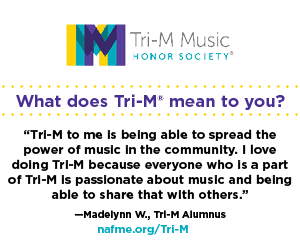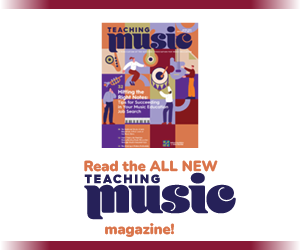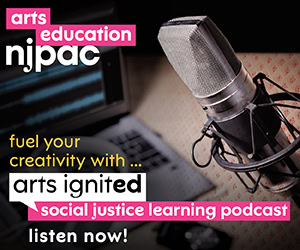/ News Posts / The Promise of Artistic Process
The Promise of Artistic Process
Social Emotional Learning (SEL) Aligns the Standards
By NAfME Members Scott Edgar, Fran Kick, and Lori Schwartz Reichl
“An ounce of performance is worth pounds of promises.” ~ Mae West
The pandemic has limited the ability for performing arts educators and students to perform to the degree we once had. In many schools, reductions have been placed on the quantity of students permitted in a given learning area; restrictions have been placed on how close students can be spaced from one another; rehearsal and performance venues have remained off limits; and opportunities for performance have been cancelled or postponed. Safety, which needs to be educators’ moral compass as we continue to move forward this academic year, is going to dictate how frequently performances occur and how differently they look, sound, and inspire.
Most ensemble directors will confirm that performing is the core music standard for which we spend the most time preparing. It’s the ultimate result of the ensemble’s preparation and often motivation. However, the National Core Music Standards in the United States also include creating, responding, and connecting. What happens when the standard of performing is restricted? Will music educators consider other performance avenues, both live and virtual? Or, perhaps we will focus on the three remaining standards with greater emphasis? The promise of artistic process still exists. Are we, as music educators, acknowledging and accepting this?

Source: https://www.nationalartsstandards.org/
Prior to the pandemic, many music educators might have potentially painted themselves into a corner by defining music education primarily based upon performance success. However, at the onset of the pandemic, if one perused social media one may have seen music teachers posting in a frenzy about not being able to “do” what they and their students once did—perform.
Quotations such as “I have to lower my bar or expectations.” “What will we do now?” and “I’m a band director!” were plastered everywhere. The idea of the concert band, or the concert choir, or the full-orchestra, or the dance company, or the full ensemble versus the individual being the center focus of the arts curriculum has permeated for years. Yes, the full ensemble is important. Yet it is the individual musician/performer who is ultimately the primary core contributor in any ensemble. When the individual student performers improve, the entire ensemble will improve. Many performing ensemble directors forget that our licensure is in the field of music education which involves teaching students how to learn music—not only perform it. It is the individual student and their development as a person, learner, and musician that makes any program successful.

Source: Wayne Markworth and Fran Kick, Centerville High School, Ohio
When we define our role of “band director,” or “choral conductor,” or “orchestra conductor” as fixers of notes and rhythms in search of a clean performance, we’re going to find ourselves, at the very least, not meeting our students’ needs this school year. The trauma our students have brought back with them, after months of not engaging in a formal educational setting with disruptions to navigate, requires a different approach to make music education relevant to our students. We’ve always taught students to be resilient in our performing ensembles. Now, we need to help them to be resilient at an individual level for the greater good of music education.
“We’ve always taught students to be resilient in our performing ensembles. Now, we need to help them to be resilient at an individual level for the greater good of music education.”
When performance is restricted, many music educators have become concerned about what we will accomplish in our learning spaces. The pandemic has allowed us to broaden our point of view beyond “just performing” and provided a promise to more equally align the remaining standards. This realignment could potentially allow students to individually fall in love with music in a new way! The challenge that we now have is how to build relationships with students if/when we’re not able to meet in person.
Creating a Path to Performance
Social Emotional Learning (SEL) is a skill-based approach that can help navigate this transition by building students’ self-awareness, self-management, social-awareness, relationship-management, and responsible decision-making skills (simplified to the three goals of: SELF, OTHERS, DECISIONS). SEL enables us to respond to challenges instead of reacting to them. Music is inherently emotional. It makes us feel. Music is social. It has been a rallying call for humans, always. It is essential that music teachers capitalize on the connections between SEL and music—it is our secret weapon with super powers, and our students need it and need music education now more than ever!
For SEL to be effective in teaching students the life skills needed to navigate their world after they leave our music classroom, it must be embedded into curricular content. For us, as music educators, it must be musical. We must make SEL intentional and meaningful—it does not “just happen,” and we cannot rely on the inherent fertile ground and potential that music education provides to teach our students these skills. If we are relying on music to latently teach these skills instead of music educators intentionally embedding SEL into their work, we will miss a great opportunity. SEL is not another box we need to check or another item we need to squeeze into our time with students. When done well, Musical SEL (MSEL) should feel like great music teaching! If it feels like SEL is distracting from teaching music, then we are not doing it optimally, nor maximizing the true power of music.
Voice and Choice in the Music Classroom
Two central thoughts are at the heart of SEL when troubleshooting this concern. We need to honor our students’ voices. Maybe we haven’t provided a space to amplify their voice and vision as much as we should have in the past. However, now we can ask students what they want out of their musical education. What can they bring to the table? What can they do to help our programs thrive? Then, we need to give them choices. Oftentimes our students, while highly effective at working well within our programs, generally do not have a lot of choices. If we can start to unpack voice and choice, then our students will still have the ownership and pride we have come to develop as an entire ensemble. Students will be energized and inspired to contribute productively to our programs by building relationships in new, unique, and more individualized ways.
“If we are relying on music to latently teach these skills instead of music educators intentionally embedding SEL into their work, we will miss a great opportunity.”
Aligning the Standards
How can we utilize SEL to align our music standards (when performing is restricted) and allow students to have a voice and choice in our program? Consider these strategies:
Creating. Use the essential questions from the national music standards to form lessons, produce writing prompts for reflection, or facilitate significant discussions with students:
- “How do musicians generate creative ideas?”
- “How do musicians make creative decisions?”
- “How do musicians improve the quality of their creative work?”
- “When is creative work ready to share?”
Responding. Understand how students are responding to music during a global pandemic, a social justice movement, and an evolution in education. Their responses to music are often informed by analyzing the social, cultural, and historical context. Ask students to elaborate on the following prompts:
- Explain what music you have chosen to listen to or perform recently.
- Identify reasons for selecting this music.
- Interpret the expressive nature of this music.
- Identify the effect the music is having on you.
- Identify music that is the “theme song” for a social justice issue you are passionate about.
Connecting. Make meaningful connections to real-life scenarios. Many authors, composers, and performers have admitted to experiencing writing/performance block during the pandemic. They have shared the reasonings for this, how they have overcome it, and the motivation that has inspired them to write, compose, or perform again. Invite these artists into your learning space (face-to-face, virtually, or through a recording) to share their personal interests, experiences, ideas, and knowledge of creating, performing, and responding. Allow your students to ask questions of these artists. Then, ask your students how they can relate through their discipline, experiences, and daily life.
*See www.selarts.org for more ideas to intermix SEL and the National Core Arts Standards.
Fulfilling the Promise
The promise of artistic process still exists and can be amplified through SEL regardless of face-to-face or virtual instruction! The strategies of creating, responding, and connecting, allow us to honor our students’ voices and continue to build relationships with them. We can acquire the knowledge, attitude, and skills to understand our students’ emotions, help to navigate these emotions, establish and maintain positive relationships with them, and provide students with choices to make responsible decisions about their music education. While we long for traditional performances to resume, we can still achieve artistic processes. We must promise that music education can survive and thrive during times of uncertainty, even if it looks different.
About the authors:
Scott Edgar is author of Music Education and Social Emotional Learning: The Heart of Teaching Music and is an Associate Professor of Music, Music Education Chair, and Director of Bands at Lake Forest College. He received his Doctorate of Philosophy in Music Education from the University of Michigan, his Masters degree in Education from the University of Dayton, and his Bachelor of Music in Music Education degree from Bowling Green State University.
 Fran Kick is the author of What Makes Kids Kick and since taking an educational leave of absence from teaching instrumental music, developed a part-time speaking adventure into a full-time mission. Today, Fran presents virtually and in-person more than one hundred programs every year across the United States and Canada to thousands of college/university, high school, and junior high/middle school students, plus the many people who work with them. He has his B.A. in Music Education and a M.A. in Educational Psychology.
Fran Kick is the author of What Makes Kids Kick and since taking an educational leave of absence from teaching instrumental music, developed a part-time speaking adventure into a full-time mission. Today, Fran presents virtually and in-person more than one hundred programs every year across the United States and Canada to thousands of college/university, high school, and junior high/middle school students, plus the many people who work with them. He has his B.A. in Music Education and a M.A. in Educational Psychology.

Photo: Richard Twigg Photography
Lori Schwartz Reichl is the author of more than 60 articles and interviews for an assortment of music education publications. She is also co-author (with Robert Sheldon) of the e-resource Hit the Highest Notes: Tips from the Coordinator and Conductor for Hosting a Successful Honor Ensemble Festival. Lori’s experience of establishing and maintaining band programs in various educational settings has transformed her career into serving as an active adjudicator, clinician, conductor, instructor, and speaker. Visit her at MakingKeyChanges.com.
Did this blog spur new ideas for your music program? Share them on Amplify! Interested in reprinting this article? Please review the reprint guidelines.
The National Association for Music Education (NAfME) provides a number of forums for the sharing of information and opinion, including blogs and postings on our website, articles and columns in our magazines and journals, and postings to our Amplify member portal. Unless specifically noted, the views expressed in these media do not necessarily represent the policy or views of the Association, its officers, or its employees.
October 13, 2020. © National Association for Music Education (NAfME.org)
Published Date
October 13, 2020
Category
- Social Emotional Learning
- Standards
- Technology
Copyright
October 13, 2020. © National Association for Music Education (NAfME.org)







